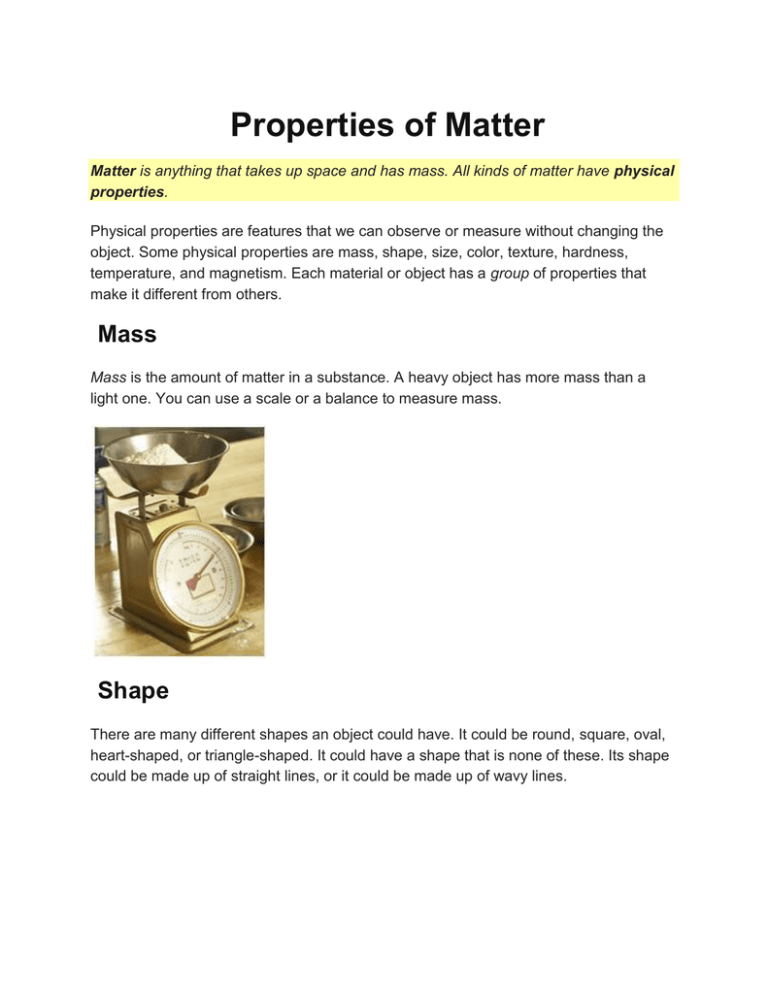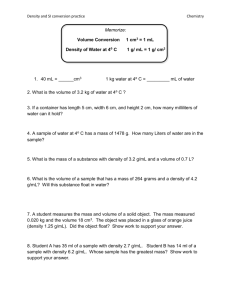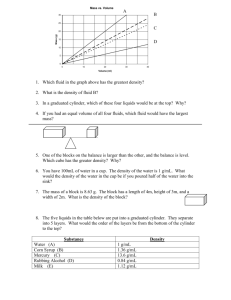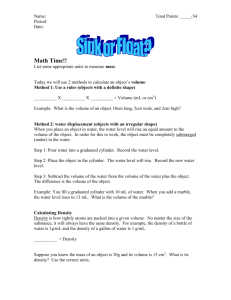
Properties of Matter
Matter is anything that takes up space and has mass. All kinds of matter have physical
properties.
Physical properties are features that we can observe or measure without changing the
object. Some physical properties are mass, shape, size, color, texture, hardness,
temperature, and magnetism. Each material or object has a group of properties that
make it different from others.
Mass
Mass is the amount of matter in a substance. A heavy object has more mass than a
light one. You can use a scale or a balance to measure mass.
Shape
There are many different shapes an object could have. It could be round, square, oval,
heart-shaped, or triangle-shaped. It could have a shape that is none of these. Its shape
could be made up of straight lines, or it could be made up of wavy lines.
Size
Objects can also be different sizes. They can be tiny, small, large, or huge. When telling
something's size, you can also use words like "larger," "smaller," "largest," or "smallest"
to compare the sizes of different objects.
There are about three different sizes of buttons in the picture. Some are small, some
are larger, and one button is the largest. Can you find the largest button?
Volume
Volume is the total amount of space that something takes up in all three dimensions. If
an object is shaped like a box, you can find its volume by measuring each side and
multiplying them together using the equation:
Volume = length × width × height
Another way to find the volume of something is to see how much water it displaces, or
moves out of its way. To measure this, use a graduated cylinder or some other tool for
measuring the volume of liquids. When you put an object in the water, the water level
will rise. How much the water level changes is equal to the volume of the object. For
example, look at the pictures of the graduated cylinders below.
Water in a graduated cylinder
A marble is added
In the first graduated cylinder, which contains only water, the volume is 15 mL (or 15
cm3). In the second picture, a marble has been added, and the volume of the two
materials in the cylinder is 18 mL (or 18 cm3). To find the volume of the marble, we have
to subtract the volume in the first cylinder from the volume in the second one.
The marble's volume is 18 cm3 - 15 cm3 = 3 cm3
Color
Another physical property an object can have is color. For example, a fire engine can be
red. The sky sometimes looks blue. Grass is very often green. The gum balls in the
picture show how sometimes, objects are exactly alike except for their colors.
Texture
The way something feels to you when you touch it is called texture. Some textures that
objects can have are soft, smooth, rough, bumpy, silky, sticky, and chalky.
The candies in the picture have different textures. The gum drops are rough. The gum
balls are smooth. The licorice might be sticky.
Hardness
Hardness is another physical property. You can compare hardness by rubbing one
material against another. For example, a diamond will scratch glass. Talcum powder
won't. A diamond is harder than glass. Talcum powder is softer than glass.
Chalk leaves marks on the sidewalk because the concrete is harder than the chalk.
Flexibility
Flexibility tells whether an object can bend. Things that are flexible can change shape
easily by bending or folding. Cloth is flexible, but a steel pipe is not.
A sponge is flexible and can be squeezed into a different shape. Rocks are hard, and
they usually will not change shape no matter how hard you squeeze.
Strength
Some materials are easier to break than others. For example, if you squeeze an egg, it
will break. If you squeeze a golf ball, it will not. The golf ball is made of something
stronger than the egg shell.
A pencil is usually easier to break than a pen because it is made of materials that are
not as strong.
Another way to measure strength is by how much weight something can hold or
support. If you step on a sturdy chair, it can support your weight because it is strong. If
you step on a shoe box, it may be crushed by your weight instead of holding you up.
This is because the cardboard is not as strong as the wood or sturdy plastics that chairs
are made of.
Temperature
How much heat is in something? This is temperature. Steam has lots of heat, and it has
a high temperature. Ice has little heat, and it has a low temperature.
You measure temperature with a thermometer. Thermometers might have numbers and
an arrow, like the one in the first picture. They might be glass with liquid inside, like the
one in the second picture. They could even be digital and have only numbers you read
off of a tiny computer screen.
Magnetism
Can a material be moved by a magnet, even if the magnet is not touching it? This is
called magnetism. Metals that are made at least partly of iron or nickel will be attracted
to magnets.
The magnet in the picture is showing how iron filings (tiny pieces of iron) are moved by
a magnet, even though the magnet is not touching the filings.
Sink, Float, or Dissolve
When an object is put in water, it may sink down under the surface of the water like a
rock or a coin. It may instead float on top of the water like the toy duck shown below.
An object or material may dissolve into water. If you dissolve sugar or salt into water,
you will not be able to see the sugar or salt, but it is still there. You can taste it if you
take a sip of the water.
Conductivity
Something conducts heat if heat can easily move from one part of it to another, or even
into or out of it. Something conducts electricity if electricity can easily move through it.
Most metals conduct both heat and electricity. Cloth does not conduct either one well.
Salt water conducts electricity but not heat.
Cloth potholders do not conduct heat well.
In the picture above, the pot is made of metal. Since metal is a good conductor of heat,
it feels hot to the touch when the food inside it is hot. Cloth potholders will help keep the
heat from flowing from the metal into hands and causing burns.
Comment on Lesson Prev 1 2 3 4 5 6 Next
Copyright © 2012 Study Island - All rights reserved.







